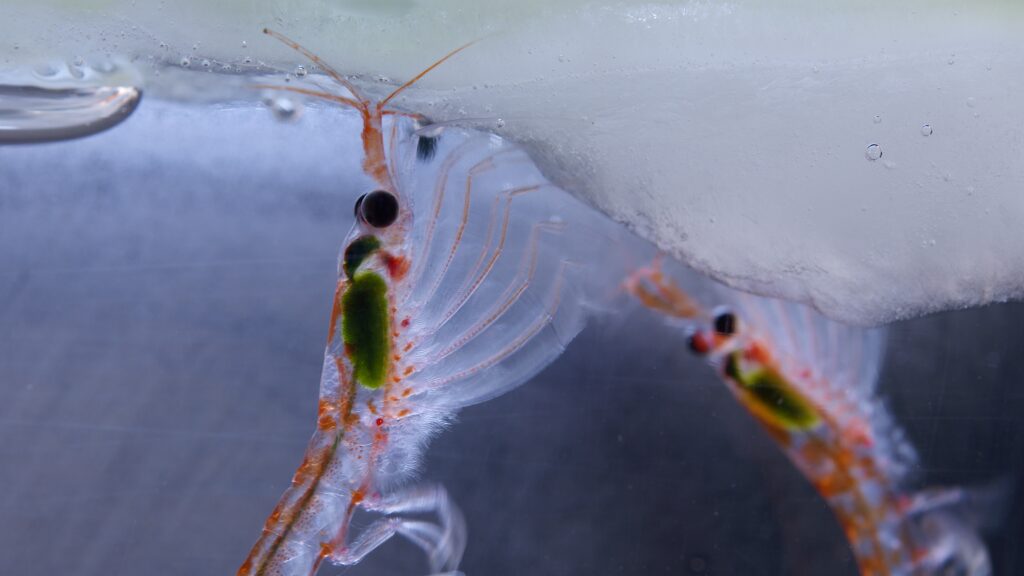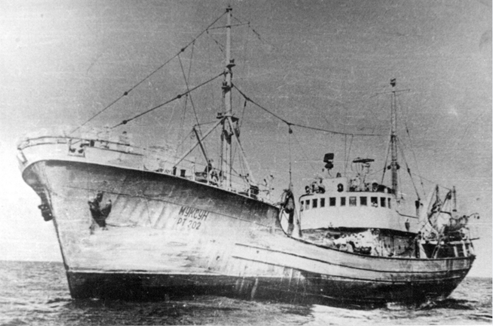Photo by Simon Payne © Australian Antarctic Division
Ecosystem-based management of krill fishery
It would be possible to write a whole book on krill – in fact, a number of people have!
There are a number of species of krill in the Southern Ocean, but one species, the Antarctic krill, Euphausia superba, dominates, making up an estimated biomass of around 380 milliontonnes1. Of this, over half is eaten by whales, seals, penguins, squid and fish each year, and is replaced through reproduction and subsequent growth of the krill population. Krill can live up to 11 years in aquariums but in the wild they probably live for 5 to 6 years, spawning when they are 2 to 3 years old.
Krill are important in the food chain because they feed on phytoplankton, and to a lesser extent zooplankton, making nutrients available to other animals for which krill make up the largest part of their diet. For this reason, krill are considered a keystone species in the Southern Ocean ecosystem.

We explained in blog #1 that it was concern about the growth of the krill fishery, and the knowledge that krill was a keystone species in the Antarctic ecosystem, that led the Antarctic Treaty Consultative Parties to initiate the negotiations that led to the 1980 agreement on the CAMLR Convention. We also explained that around this time SCAR had a big role in providing scientific advice that supported the early work of CCAMLR. But scientific research on the Antarctic ecosystem, and on krill, had started much earlier, including through the Discovery Investigations, a program of research funded by the UK in the first half of the 20th century. The large number of publications arising from this work included reports on the biology and ecology of krill, in particular James Marr’s 1962 report on “The Natural History and Geography of the Antarctic Krill”.
The Soviet Union undertook early research into the krill fishery in the 1960s. Major surveys to determine krill biomass in the Atlantic sector, where the fishery eventually concentrated, followed in 1980/81 (FIBEX), 2000 and 2019, and all involved a number of vessels and CCAMLR Members. The krill fishing companies and ARK (the Association of Responsible Krill harvesting companies) also contributed ship time for the 2019 survey. Krill biomass surveys in the Indian Ocean sector have been conducted by Australia and Japan.




Although a lot was known about krill in the 1980s, including first estimates of the total biomass coming from the FIBEX, it took CCAMLR several years to establish a practical, ecosystem-based approach to managing krill. This approach, developed in 1991, was to take the FIBEX survey estimate for krill biomass in the Atlantic sector (Area 48) and undertake many thousands of computer simulations that reflected the natural variability in krill populations to see what would happen in the future. A sustainable catch of krill was then calculated from these simulation results that safeguarded both the krill population and the food supply for dependent predators. To do this the krill population would not be allowed to be reduced from its pre-fishing level by more than 25%. This approach is precautionary, it takes natural variability into account, and is primarily focussed on minimising the impact on the ecosystem rather than maximising the size of the fishery.
This approach, captured in a set of “decision rules”, has become the practical way that CCAMLR implements its guiding precautionary and ecosystem principles, set out in Article II of the Convention (Blog #1).
In 1991 the available survey data suggested that the allowable catch limit should be 1.5 million tonnes in the Atlantic sector. One additional level of precaution introduced in 1991 was to set a “trigger” level of 620 000 tonnes, and a rule that if the catch went above this level it would be necessary to set smaller area limits on the fishery.
Although new data acquired over the last 30 years has periodically led to changes in the catch limit, the trigger level has remained. The most recent estimate of krill biomass in the Atlantic sector, from a survey conducted in 2019, is 62 million tonnes and the catch limit for the Atlantic is 5.61 million tonnes. However, the 620 000 tonne trigger level is still the effective catch limit in place, and smaller area limits are set in order to avoid concentration of the fishery in one area where it might impact local predators.
CCAMLR has been able to continue to monitor the impact on krill predators, and the effectiveness of its management of krill, through the CCAMLR Ecosystem Monitoring Program (CEMP) (blog #2). The Scientific Committee is continually developing its ecosystem approach to krill management with more sophisticated models of krill and predator populations, using data acquired by fishing vessels, research vessels and predator research programs such as CEMP. All krill vessels carry scientific observers who take biological samples of the catch and record bycatch and interactions with seabirds and marine mammals (blog #9).
Krill is a source of oil, used as a health supplement, and is eaten as canned or frozen krill tails. It is also used in aquaculture feed. Over the last 40 years the krill fishery has undergone many changes. In the 1980s krill was fished mainly by vessels from the Soviet Union, Japan, Chile, Poland and Korea. In the early 1990s the catch dropped to ¼ of its size in the 1980s and remained small until 2010 when it started to grow again. At this time new nations entered the fishery which had not been present in the early fishery, and in recent years the vessels have been from Chile, China, Korea, Norway and Ukraine. New fishing methods, products and markets have been developed.

CCAMLR’s success has been the conduct of many years of multi-Member coordinated research on krill, and to put in place precautionary management rules or Conservation Measures that prioritise safeguarding the ecosystem. The krill catch has always remained within sustainable limits, and at levels that are less than 1% of the size of the krill population. CCAMLR’s management of krill has remained true to the objective of the Convention; conservation of Antarctic marine living resources which includes rational use..
For more information on CCAMLR’s management of the krill fishery see the krill Fishery Report. For data on catches see the CCAMLR Statistical Bulletin.